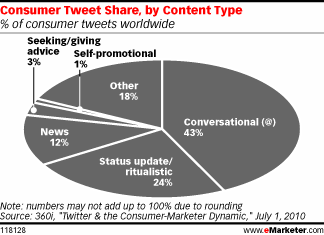In Social Media, Always Be The Host, Not The Master!
Brand v/s Consumer Activity on Twitter
According to a report by eMarketer, “marketers are using a significantly greater share of their tweets to push out news and information rather than converse with other users. Just 16% of brands’ tweets use the “@” symbol, a sign of back-and-forth engagement on the service – very low compared to consumer stats, which is almost 43%.”
Stats in Isolation, do not Mean Anything
Indeed, the very fabric of Internet is changing into a platform that facilitates conversation. Consumers are now engaging in conversation with countless others through network of friends, across international boundaries, and who probably they have never physically met – connected through shared interest, belief or philosophy. In this evolution of consumer-brand relationship, Brands that have successfully adapted to the changing consumers are the ones that have found ways to foster and nurture a community of their most loyal fans.
However, an “engagement service/ system” for brands, which is both scalable and efficient, is essentially a community of enthusiasts and loyal supporter who engage for and on-behalf of the brands, and not necessarily the numbers of @ they accumulate over time.
Brands Builds Communities, Gathers Advocates
If you are spending your ‘social media time’ to listen to all mentions of your brands as they happen, and respond to them real time –either you are not working strategically or you have surplus resources. Assigning a dedicated resource 24×7 to respond to mentions is not “long-term” thinking. Listening is very important – and, there is a value in aggregating response, which is not collected in isolation – to understand patterns / behaviors and to identify collective insights of your brand mentions. However, it is neither scalable nor necessary to put a resource for real time response to all brand mentions – as they happen. A real time response is great, but it need not come from you. Instead, a brand can help create and manage a thriving community in each network – that stands up for the brand. For example, when a prospect asks a question about a product, and a friend from the network responds to this query, the recommendation sounds much more real and convincing.
The Intuit Example
One brand that comes to mind, when you think of community involvement is Intuit. In 2009 the company built community right into their products. Users have become company ambassadors and today, 70% of users get their answers from the community site versus customer support – significantly driving down support costs. Intuit is leveraging Twitter and observing customer-created videos on YouTube that showcase Intuit’s products.”
There are endless list of successful brand communities like Running Plus (Nike), My Starbucks Idea, Dell Ideastrom, eBay Powersellers etc. These communities are present everywhere and doing well with or without user interaction directly.
Bring Community Building in your Agenda

Build your community - From diverse population, with same passion for your brand.
Here are some pointers which will help you kick start your own community with better results:
- Identify the loyal supporters of your brands – These are the influencers, who amplify your messages to a larger audience, and are those few loyal supporters, who are also respected in their communities. It makes a great sense to nurture, and acknowledge their help in building your brand. Read about how you can get this information from ObjectiveMarketer.
- Foster many-to-many relationships. A brand community is not a one-to-many relationship—that’s brand autocracy. People need to interact with each other and not simply “the brand” if you want to create a successful brand community. Therefore, build peer-to-peer communication into your structure.
- Don’t create “more.” Massive amounts of information is being created about your brand and distributed across the web everyday. Rather than spend time asking people to create more content, make it easy for people to enjoy and engage with the stuff that already exists.
- Let your advocates advocate. The only way to inspire your best advocates is to let them work their magic without interference except in issues of ethics and legality. Your advocates are not pawns—they are your partners, so treat them that way.
- Observe the 1-9-90 rule. This new rule, pioneered by Josh Bernoff and Charlene Li in their seminal book Groundswell, is quickly becoming a standard: 1% of your population will create content, 9% will comment or engage with it, and 90% will just browse. Voyeurs rule the online world, so keep this in mind.
Finally always keep in mind the three golden rules:
- WORD OF MOUTH DRIVES CHOICE
- CUSTOMERS TRUST, RELY AND ACT ON ADVICE FROM PEOPLE THEY KNOW
- ALWAYS BE THE “HOST” & NOT THE “MASTER”
An interesting article was published on The Fast Company, and the following thoughts do great justice to summarize the content of this blogpost “The one thing to remember: the turbo charger (social media) is useless without an engine (passionate customers). Businesses must offer a great customer experience to draw in those passionate customers, who will in turn spread the word about your products and services.”

